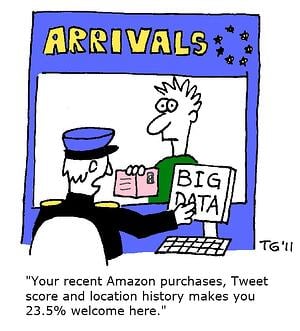Big Data and Behavioral Intelligence
By 2018,  the United Nations estimates there will be 7.6 billion people living on Earth. By 2020, an estimated 50 billion devices will be connected to the internet, and web traffic will have more than doubled. From low-cost, low-power programmable sensors that transmit data to vehicles that stream diagnostics straight to your smartphone, this explosion of connected devices is changing the way we live our lives, creating huge sets of data that will drive efficiencies and productivity for businesses and individuals alike.
the United Nations estimates there will be 7.6 billion people living on Earth. By 2020, an estimated 50 billion devices will be connected to the internet, and web traffic will have more than doubled. From low-cost, low-power programmable sensors that transmit data to vehicles that stream diagnostics straight to your smartphone, this explosion of connected devices is changing the way we live our lives, creating huge sets of data that will drive efficiencies and productivity for businesses and individuals alike.
(Image by Thierry Gregorius (Cartoon: Big Data) [CC-BY-2.0 (http://creativecommons.org/licenses/by/2.0)], via Wikimedia Commons)
However, a fool with a tool is still a fool, and simply collecting this data is not a viable strategy for organizations looking to capitalize on the Big Data trend. The true value of this information is extracted through sophisticated and automated analysis of the data in real-time.
A fool with a tool is still a fool.
For marketers, the race is on to develop strategies and systems to harness these sets of data as the ecosystem continues to expand and organizations begin to test new methods of gathering consumer data. When developing and implementing a data strategy, there are three key tactics that can be utilized to implement a world-class solution that will drive ROI, productivity and efficiency.
Tactic #1: Develop Clear-cut Business Goals / Objectives and ROI Measurements Against These Goals / Objectives
As previously mentioned, simply collecting consumer information and behaviors is an insufficient strategy when working with data sets. Organizations need a way to make sense of this data, and therefore, must define how they want the data to work for them. By setting business goals and objectives up front, companies are able to work from a common set of benchmarks to effectively measure their campaigns, optimize internal and consumer-facing processes, and provide a concentrated focus on the aspects of the campaign that drive the greatest ROI.
Tactic #2: Understand Consumer Device Usage and Focus on Creating a Data Strategy That Integrates All Digital Touchpoints
Consumers are no longer bound to a singular device when they communicate with brands. Rather, consumers are using multiple devices, from desktops to smartphones to tablets, throughout the lifecycle to make their purchase decision. Traditionally, marketers have looked at behaviors on each of these devices in a silo; with little integration across other digital touchpoints. A strong and successful data strategy requires marketers to focus on integration of all digital touchpoints, building out individual consumer profiles based on captured behaviors performed on any and all digital properties. By taking this cross-channel approach and coupling it with the aforementioned behavioral data, marketers are able to effectively target the right person at the right time in the right place.
Tactic #3: Develop a Singular, Sophisticated Data Engine Optimized for CRM & Personalization
The emergence of cloud computing has afforded marketers the luxury of aggregating and integrating a number of different data sources, and the concept plays a key role in developing a successful data strategy. By collecting and storing cross-channel data in a singular location, marketers can begin to write rules that will dynamically target consumers based on their previous activities. Let’s use Guitar Center as an example – imagine consumer Cameron is interested in purchasing a new guitar. He has gone on his laptop and signed up for a newsletter, providing his email, name and phone number (for SMS offers), and checking the boxes that he is interested in six-string electric guitars under $1,000. The next day, Cameron is at home on his tablet, and saves two Gibson Les Paul guitars that he likes to his Guitar Center “wish list”. Three days later, he decides its time to visit the store to try the guitars out in person. When he arrives on-site, he automatically receives a text message stating, “Hi Cameron, thanks for visiting Guitar Center! We noticed you’re interested in the Gibson Les Paul – here’s a special $200 offer if you purchase a Les Paul today!” By aggregating all digital touchpoint data in one location, marketers are able to identify that Cameron is in market, he’s interested in a specific guitar, and he’s interested in receiving offers via text message for guitars.
All of these data points, when viewed individually, have value – but it is a classic case of the whole being greater than the sum of its parts. By merging these data points to create a consumer “profile”, marketers are able to write sophisticated rules that trigger an action or message, based on the various inputs. So, in the Guitar Center example above, Cameron’s visit to the Guitar Center location triggered an action (personalized SMS offer based on the consumer’s location) that was depicted by his previous activity on Guitar Center’s digital properties.
Although the concept of Big Data analysis has marketers and organizations giddy in regards to it’s potential and impact in market, it is not a theory or practice without issues. Implications such as privacy, reliability and threats of a technology backlash are still key to its development and evolution. With the recent breach of consumer data by the NSA, data privacy has been thrust to the forefront of popular culture, and has raised legitimate concerns regarding the breadth of information that can be collected through digital channels. Now more than ever, consumers are aware of how much personal information is available, and that “private data” may be a thing of the past. The fact that consumers are more wary of the data that exists in the “cloud” may prove a significant counter force to the development of Big Data analysis.
Additional Information:
- Big Data and Business Analytics Symposium: From Analytics to Action http://engineering.wayne.edu/big-data-analytics/conference.php
- http://www.bigdata.wayne.edu
- Data Analytics: Understanding the Volume of Available Information. http://inbound.business.wayne.edu/blog/bid/251636/Data-Analytics-Understanding-the-Volume-of-Available-Information
(All accolades and credit for this tremendous blog post are for Kristin Turner who is the author and content creator.)




